
Revell 1/48 PAH-1/Bo.105
| KIT #: | ? |
| PRICE: |
£7.99 |
| DECALS: | Four options |
| REVIEWER: | Carmel J. Attard |
| NOTES: |

| HISTORY |
The Bo
105A made its maiden flight on the 16th February 1967 at
Ottobrunn in Germany with Messerschmitt-Bolkow and Blohm
pilot, Wilfried von Engelhardt, at the controls. The German Civil Authority
certified the helicopter on 13 October 1970 and production for German civil and
law enforcement organizations began shortly afterwards. Further safety
certification by the FAA was granted in April 1972 with United States export
orders following.
The
Bo 105C was developed in 1972 and the German Ministry of Defence selected this
model for its light observation helicopter program, purchasing 100 helicopters
in 1977. A specialist anti-tank version armed with Euromissile-
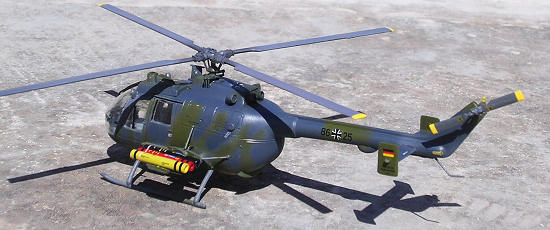 In
1976, the Bo 105CB was developed with more powerful Allison 250-C20B engines.
This was further developed as the Bo 105CBS with the enlargement of the fuselage
by 10 inches to meet American market demands for emergency medical service
operations, with this version becoming known as the Bo 105 Twin Jet in the
United States.
In
1976, the Bo 105CB was developed with more powerful Allison 250-C20B engines.
This was further developed as the Bo 105CBS with the enlargement of the fuselage
by 10 inches to meet American market demands for emergency medical service
operations, with this version becoming known as the Bo 105 Twin Jet in the
United States.
In
1984, the Bo 105LS was developed with the enlarged fuselage of the Bo 105CBS
combined with more powerful Allison 250-C28C engines to increase the maximum
take-off weight.
Production ended in 2001, due to the Bo 105 being superseded by the more modern
Eurocopter EC-135 after 1,406 machines had been built. The last BO105-LS was
delivered in 2009 to Dam Helicopters Inc of Nelson BC Canada.
Being the first light twin-engined helicopter in commercial service, it gained
widespread use over rural areas (policeand ESM / Medevac) as well as offshore.
The
four-blade hingeless main rotor,a worldwide first, with composite blades ensures
high maneuverability. A Bo 105CBS used for promotional purposes by Red Bull USA
is fully aerobatic, performing loops, rolls, Immelmmans and other maneuvers
normally regarded as for fixed-wing aircraft only. All main systems (hydraulics,
electric, fuel, lubrication) were designed to be fully redundant.
| THE KIT |
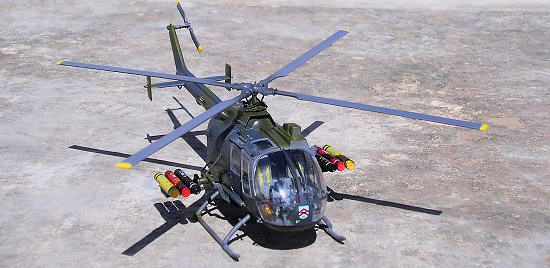 This is another
Revell kit arriving in the usual blue box with all contents in dark green
plastic and its sprues sealed in bags. Either of the two versions of the Bo-105
can be built from the kit, a PAH1 belonging to the ‘Round-up-Team ‘ and hence
carries a set of six rockets/grenade launchers, or a Bo-105 VBH of “Fly Out
1994” in very colourful markings when the unit disbanded in Bavaria. The clear
parts come in a separate bag. There is hardly any flash and the surface detail
of the parts is very neatly done.
This is another
Revell kit arriving in the usual blue box with all contents in dark green
plastic and its sprues sealed in bags. Either of the two versions of the Bo-105
can be built from the kit, a PAH1 belonging to the ‘Round-up-Team ‘ and hence
carries a set of six rockets/grenade launchers, or a Bo-105 VBH of “Fly Out
1994” in very colourful markings when the unit disbanded in Bavaria. The clear
parts come in a separate bag. There is hardly any flash and the surface detail
of the parts is very neatly done.
| CONSTRUCTION |
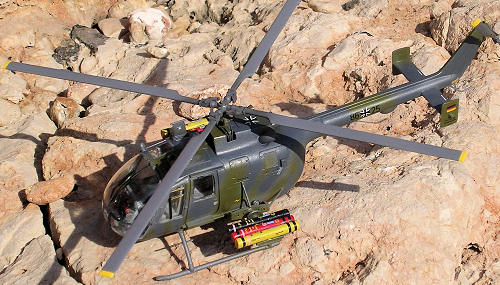 The construction
was carried out by simply following the instruction sheet, which depicts part
item, and position where it goes. The first area to be assembled is the cockpit
station with two seats forward and a combined 3-seat bench at the rear. Seat
straps on front seat are moulded on and these are embossed in such a way to make
them easy to paint on. The areas for placement of instrument panel decals are
also indicated. There is lack of detail to areas as cabin interior walls or
interior of doors. The rest of the fuselage all seems to fit well and there was
only a small area on the roof and another area under the fuselage that required
filling with a small quantity of putty followed by smooth sanding.
The construction
was carried out by simply following the instruction sheet, which depicts part
item, and position where it goes. The first area to be assembled is the cockpit
station with two seats forward and a combined 3-seat bench at the rear. Seat
straps on front seat are moulded on and these are embossed in such a way to make
them easy to paint on. The areas for placement of instrument panel decals are
also indicated. There is lack of detail to areas as cabin interior walls or
interior of doors. The rest of the fuselage all seems to fit well and there was
only a small area on the roof and another area under the fuselage that required
filling with a small quantity of putty followed by smooth sanding.
The main propeller
hub assembly is quite well represented at this scale and one may decide at some
stage if the propeller has to remain rigid or is left free to rotate. The box
art is quite useful for reference in adding further detail. Among such possible
detail is a brightly coloured fire extinguisher positioned in the foot well area
of the starboard front seat, and transmission cables which connect from a
rectangular pylon to the back of the instrument panel. Another very pronounced
detail, which is missing in the kit, is a 1.5mm diameter strut that connects the
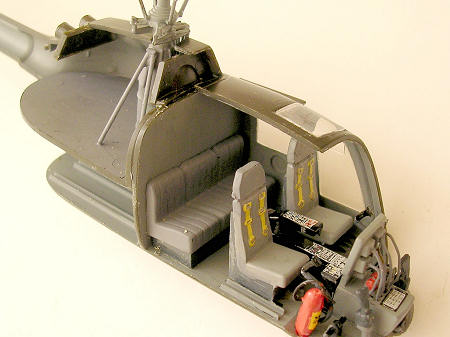 guard plate also needs to be added
to the starboard side of the upper fuselage close to the
exhaust duct. It is apparent that the pictures on the side of the box which
illustrate the finished model are of another version of the helicopter, where
the cable detail was covered with a front panel and are therefore are of little
use as reference for the kit inside.
guard plate also needs to be added
to the starboard side of the upper fuselage close to the
exhaust duct. It is apparent that the pictures on the side of the box which
illustrate the finished model are of another version of the helicopter, where
the cable detail was covered with a front panel and are therefore are of little
use as reference for the kit inside.
There is an aft
bulkhead that separated the front crew compartment from the engine compartment.
The fuselage all fits together well and there was only a small area on the roof
and another under the fuselage that required filling with a small quantity of
putty. The undercarriage skids are of reasonable scale dimensions, so care needs
to be taken when parting these from the runner to preserve their smooth
continuous edges. Care is also needed to ensure that these dry with the correct
angle and alignment when glued into place. In addition, the engine assembly
contains control links, which are close to the rotor head, and care is needed
not to break any of these. Turning to the cockpit glazing, the clear parts come
in a separate bag. They are well moulded and very clear, with fine rivet detail
on their framework in a style typical of Revell. They are all thin in section
and showcase any additional work that that the modeler puts into the interior of
the cockpit. The transparent pieces fit well with no effort whatsoever. With all
the major parts in place, I noticed that no ballast weight would be needed in
the forward fuselage area since the skids are long enough to hold the model
level.
| COLORS & MARKINGS |
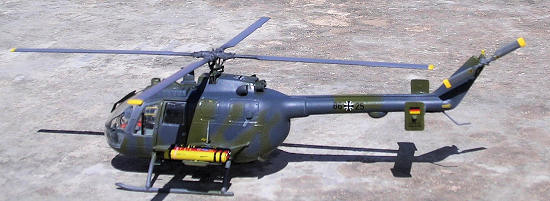 The Bo-105 is finished in a wrap round
camouflage of dark grey and dark olive green which seemed to suite the kit very
well. The decals included standard markings or highly attractive colourful
markings, complete with a full set of coloured
The Bo-105 is finished in a wrap round
camouflage of dark grey and dark olive green which seemed to suite the kit very
well. The decals included standard markings or highly attractive colourful
markings, complete with a full set of coloured
| CONCLUSIONS |
The kit builds into a fine replica of
the Bo-105 and it is certainly recommended to the 1/48-scale modelers
particularly keen on Helicopters and VTOL aircraft.
| REFERENCES |
http://en.wikipedia.org
Carmel J. Attard
July 2009 Copyright ModelingMadness.com If you would like your product reviewed fairly and quickly , please
contact
the editor or see other details in the
Note to
Contributors.